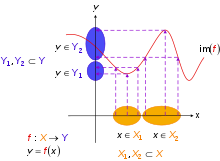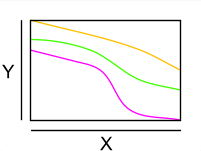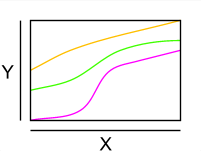Injective function
![]()
This article is about injective mappings. For injective moduli and other injective objects, see Injective object.
Injectivity or link uniqueness is a property of a mathematical relation, i.e. in particular also of a function (for which one usually also says "mapping" equivalently): An injective function, also called injection, is a special case of a left-unique relation, namely the one in which the relation is also right-unique and left-total.
A function 




The target set can therefore not be less powerful than the definition set, i.e. it cannot contain fewer elements.
The image set 





That a mapping 








Illustration of an injection. Each element of Y has at most one original image: A, B, D one each, C none.
Examples and counterexamples
- Extra-mathematical example: The function that assigns the number of the current identity card to each citizen of the Federal Republic of Germany with an identity card is injective, where the set of all possible identity card numbers is assumed as the target set (because identity card numbers are only assigned once).
denote the set of natural numbers and
the set of integers.





- Any function
from a two-element set
into a one-element set
is not injective, because necessarily both elements of
are mapped to the single element


Non-injective function
Properties
- Note that the injectivity of a function depends
only on the function graph
(unlike surjectivity, which also
depends on the target set read from the function graph).
- function
is injective exactly if for all subsets
holds:
- function
is injective if and only if
for all
(where denotes
the primal image function).
- If the functions
and
are injective, then the composition (concatenation) is also
injective.
- From the injectivity of
it follows that
is injective.
- function
with non-empty definition set
is injective if and only if
a left inverse, that is a function
with
(where
denotes
the identical mapping to ).
- function
is injective if it is left truncable, i.e. if for any function
the equality
follows from (This property motivates the term monomorphism used in category theory, but for general morphisms injective and left truncable are no longer equivalent).
- Any function
is
representable as a concatenation , where
surjective and
injective (namely an inclusion mapping).
- A continuous real-valued function on a real interval is injective if it is strictly monotonically increasing or strictly monotonically decreasing in its entire domain of definition, i.e. if for any two numbers
and
from the domain of definition the applies: From
f ( a
(increasing), or from
f ( a
(falling).
- A group or vector space homomorphism is injective exactly when its kernel is trivial, i.e. consists only of the neutral element or the zero vector.

Three injective strictly monotonically decreasing real functions.

Three injective strictly monotonically increasing real functions.
Mightiness of sets
The notion of injection plays an important role in set theory in the definition and comparison of powers, a notion that generalises the number of elements from finite sets to arbitrary sets. Two sets 










Drawer closure
A frequent inference scheme in proofs, especially in number theory, uses the statement that a mapping 





Number of injective mappings
The number of injective mappings from a defining set 


In combinatorics, this corresponds to a variation without repetition.
Questions and Answers
Q: What is an injective function in mathematics?
A: An injective function is a function f: A → B with the property that distinct elements in the domain map to distinct elements in the codomain.
Q: What is the relation between elements in the domain and codomain of an injective function?
A: For every element b in the codomain B, there is at most one element a in the domain A such that f(a)=b.
Q: Who introduced the terms injection, surjection, and bijection?
A: Nicholas Bourbaki and a group of other mathematicians introduced the terms injection, surjection, and bijection.
Q: What does an injective function mean?
A: An injective function means that each element in the domain A maps to a unique element in the codomain B.
Q: How is an injective function different from a 1-1 correspondence?
A: An injective function is often called a 1-1 (one-to-one) function but is distinguished from a 1-1 correspondence, which is a bijective function (both injective and surjective).
Q: What is the property of an injective function?
A: The property of an injective function is that distinct elements in the domain map to distinct elements in the codomain.
Q: What is the significance of injective functions in mathematics?
A: Injective functions play an important role in many mathematical fields, including topology, analysis, and algebra, due to their property of having distinct elements in the domain map to distinct elements in the codomain.
Search within the encyclopedia



